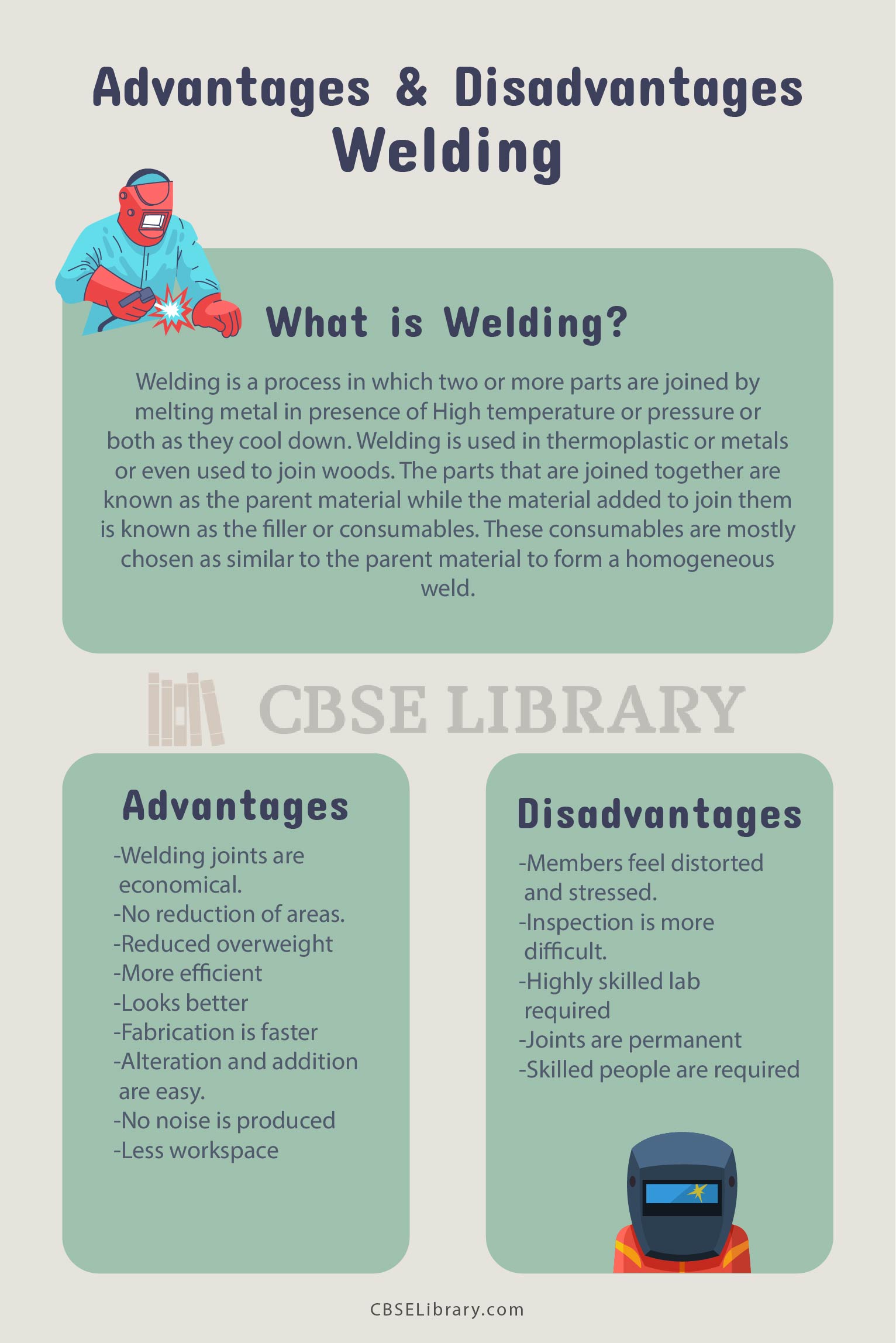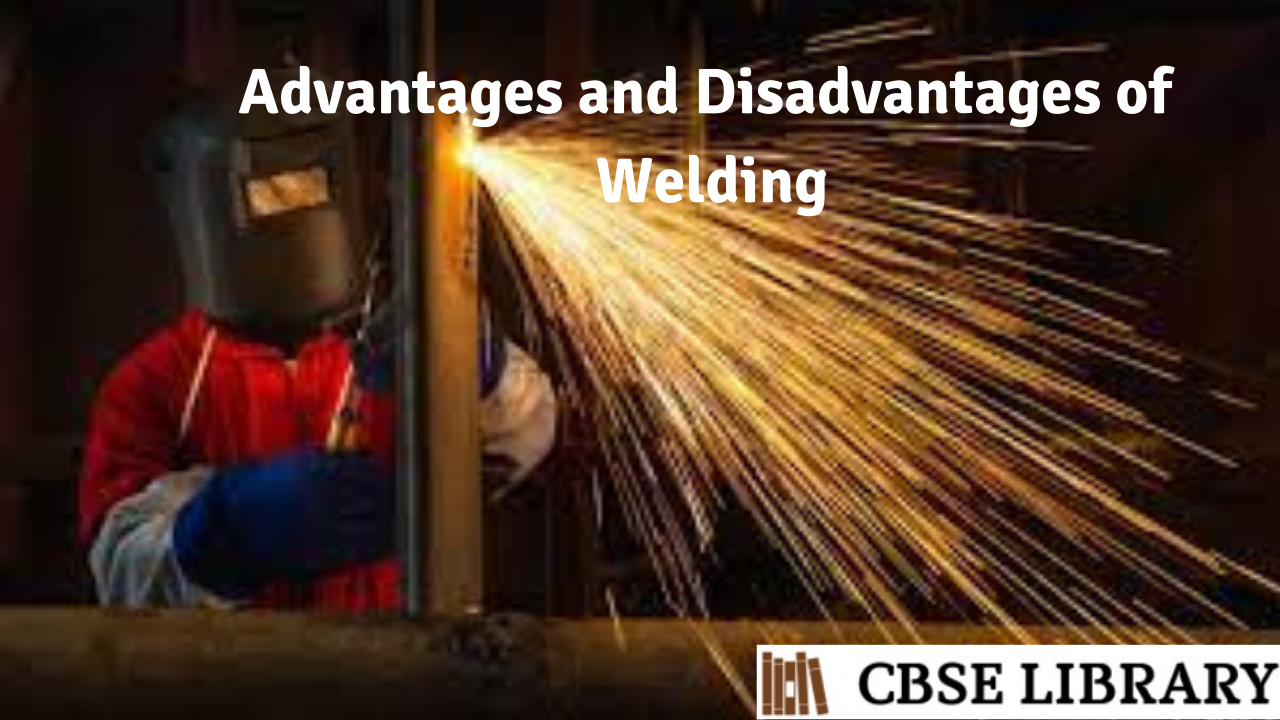Advantages and Disadvantages of Welding: Our modern world is full of metallurgy work and modern structures. These structures are huge and require specialization in work. This is the labour requirement the machine used as well as lab-made is designed in a specific and specialized manner. These modern structures are the basis of the Indian economy and welding makes this process simple and easy.
Welding is a super durable joining technique by combination, regardless of the utilization of filler metal. It is a significant manufacturing process. Welding is partitioned into two gatherings.
Combination welding: In combination welding, the metal being joined is softened and melds by the ensuing hardening of liquid metal. On the off chance that fundamental, a liquid filler metal is additionally added.
E.g., Gas welding, bend welding, thermite welding.
Pressure welding: The metals being joined never softened, the association of metal acquired by use of tension at welding temperature.
Students can also find more Advantages and Disadvantages articles on events, persons, sports, technology, and many more.
What is Welding? Advantages and Disadvantages of Welding 2022
Welding is a process in which two or more parts are joined by melting metal in presence of High temperature or pressure or both as they cool down. Welding is used in thermoplastic or metals or even used to join woods. The parts that are joined together are known as the parent material while the material added to join them is known as the filler or consumables. These consumables are mostly chosen as similar to the parent material to form a homogeneous weld. But sometimes different consumables can also be used which is known as the heterogeneous weld. The completed form of the welded joint is referred to as weldment.
Welding is one sort of long-lasting joining process by which at least two strong parts can be joined to shape a unit. There exist numerous other joining processes including not many extremely durable joining processes and numerous brief joining processes. Other than welding, bolt joint and glue joint is likewise long-lasting joining processes. Among impermanent joining processes, clasp, cotter joint, knuckle joints, and so forth are normally utilized. In spite of the presence of numerous elective cycles, welding offers many benefits over others. The upsides and downsides of the welded joints are examined in the accompanying areas.
- Advantages of Welding
- Disadvantages of Welding
- Comparison Table for Advantages and Disadvantages of Welding
- FAQs on Pros and Cons of Welding
Types of Weld Joints
There are different types of weld joints. These are:
Based on configuration: There are mainly two types of weld joints based on configuration
- Slot weld: joint weld in which filler is around the periphery of a hole in one component to join the overlapping component is called a spot weld.
- Plug weld: Weld is made by filling a hole of a component with filler metal to join the surface of another component.
Based on penetration: There are mainly two types of the weld. They are
- Full penetration weld: when the filler metal fully penetrates the joint of two components then it is known as a full penetration weld.
- Partial penetration weld: Weld in which penetration of filler is partially or less than full penetration is known as partial penetration weld.
Based on accessibility: Based on accessibility, there are mainly two types of weld. They are
- Single side weld: When weld material is filled on one side of components to join, it is known as a single side weld.
- Double side weld: When weld material is filled on both sides of components to join, it is known as a double-sided weld.
Types of Welding
Let us briefly see the types of welding.
- Arc: This technique is used mostly in my sector of automotive, aerospace, oil and gas power, etc. This is a technique that uses filler material to join the components like stainless steel, aluminium, nickel, copper alloys, etc.
- Friction: This technique is used in industries like stainless steel, aluminium, and even wind because the technique used to join the two metals is using mechanical friction.
- Electron beam: When two components are joined using high-velocity Electrons whose kinetic energy transforms into heat to melt the material.
- Resistance: It is a very fast process of welding which are of two types: spot welding and seam welding. Spot welding uses heat delivered between the electrodes to melt the material while seam welding replaces the electrodes with rotating wheels to deliver leak-proof weld.
- Laser: This process uses a laser to provide concentrated heating to join the material of a component.
Advantages of Welding
Listed are a few advantages of welding
- Welding Joints are economical: As less labour and less material are required therefore welding joints are economical.
- No reduction of areas: There is no requirement for the hole. That’s why there is no reduction of areas and structural members are more effective in taking loads.
- Reduced overweight: In welding, no filler plates or connecting angles are required; thus the overall weight of the structure gets reduced.
- More efficient: The efficiency of welded joint is more efficient.
- Looks better: Welded joints look better in appearance as compared to other kinds of joints.
- Fabrication is faster: Fabrication is faster in the case of welded joints.
- Alteration and addition are easy: The structure of a welded joint is so simple that alteration and addition become easy.
- No noise is produced: The process of Welding is so easy and effective that it doesn’t even produce any kind of noise while joining the material.
- Less workspace: The space required for welding is even less; thus workspace requirement is also less.
Disadvantages of Welding
There are a few disadvantages of Welding.
- Member feel distorted and stressed: Due to uneven heat and pressure, members of the workforce may often feel distressed or distorted during working hours which makes their work inefficient.
- Inspection is more difficult: Inspection of welding is difficult as compared to the welding process. This makes the whole process of welding a hectic and long process.
- Highly skilled lab required: The welding process requires a high level of supervision as well as a highly-skilled lab which may often lead to high expenses for the owners.
- Joints are permanent: Once joints are welded it is mostly impossible to again separate the two components. These joints are permanent.
- Skilled people are required: Since the process of welding is supervised under a highly supervised lab thus, the person required for the workspace must also be skilled.

Comparison Table for Advantages and Disadvantages of Welding
Below is the comparison chart in the form of a table.
| Advantages of Welding | Disadvantages of Welding |
| Welding joints are economical | Members feel distorted and stressed |
| No reduction of areas | Inspection is more difficult |
| Reduced overweight | Highly skilled lab required |
| More efficient | Joints are permanent |
| Looks better | Skilled people are required |
| Fabrication is faster | – |
| Alteration and addition are easy | – |
| No noise is produced | – |
| Less workspace | – |
FAQs on Pros and Cons of Welding
Question 1.
What do you mean by welding?
Answer:
The process of fabrication for joining two components together using highly heated metals or fillers to join is called welding.
Question 2.
What is the principle of Welding?
Answer:
Welding is coalescence produced by the heating of metal at suitable temperatures with or without the use of pressure or any filler material.
Question 3.
What are the advantages of welding?
Answer:
The advantages of welding are:
- Welding lays serious areas of strength for out and long-lasting joint connections.
- A basic interaction brings about extraordinary completion.
- The method, when utilized with filler material, delivers a more grounded weld than the base material.
- It tends to be performed at any spot
- It is a prudent and reasonable interaction
- It is utilized in different areas like development, car, and a lot more ventures.
Question 4.
What are the disadvantages of welding?
Answer:
The disadvantages of welding are:
- It is dangerous when performed under the well-being and security rules.
- It is a troublesome errand to destroy the joined material through welding.
- Requires gifted work and electric stockpile
